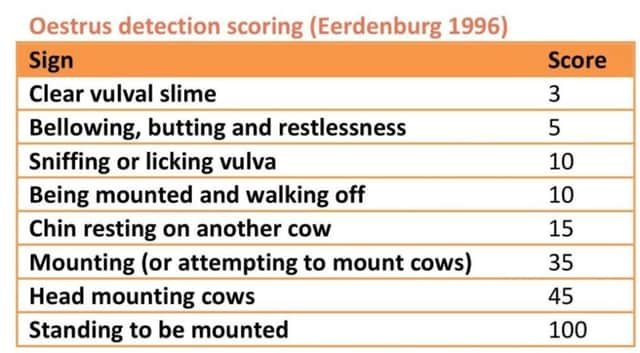Effective heat detection in cattle


Identifying cows in heat better is the area where farmers can have the most impact on fertility. Good heat detection requires patience on the part of the stockmen, plus a settled herd.
There are two main components to effective heat detection in cattle:
Are the cows in heat detected? HEAT DETECTION RATE
Advertisement
Hide AdAdvertisement
Hide AdAre the cows in heat actually in heat? HEAT DETECTION ACCURACY
Signs of heat/oestrus:
A cow or heifer standing to be mounted is the most reliable indicator or ‘PRIMARY’ sign of oestrus. Bulling cows or heifers may stand or move slightly forward with the weight of the mounting cow. Cows that move away quickly when mounted are not in true heat.
Standing cows are normally mounted over the rump, although they can be mounted over the head or forequarters in a few cases.
Other ‘SECONDARY’ signs may be seen which indicate that a cow/heifer will be coming onto heat soon or has recently been on heat:
Advertisement
Hide AdAdvertisement
Hide Adl Discharge of clear mucus - long clear elastic strings of mucus generally indicate an imminent heat. Cloudier, thicker mucus indicates a recent heat.
l Mounting other cows. Cows mounting the front of another cow are more likely in oestrus than those mounting at the back-on both occasions the cow allowing the mounting is the main culprit.
l Swelling and reddening of the vulva.
l Restless behaviour- such as increased walking, standing, following other cows and bellowing are all indicators of cows that are either in or approaching oestrus.
l Sniffing of the vulva or urine of other cows, flehmen or nose/ lip curling at other animals.
l Chin resting- both cows may be coming into heat.
l Head butting other cows.
Advertisement
Hide AdAdvertisement
Hide Adl Rubbed tail head hair and dirty flanks- due to being frequently mounted.
l Blood stains on tail or vulva- some cows and most heifers have a bloody mucus discharge one to three days after oestrus. These cattle should be watched for heat 17-20 days later.
l Decreased feed intake-less time spent feeding.
A team of Dutch researchers have devised a scoring system to give a high heat detection rate (74%) with no false positives (because serving cows at the wrong time is expensive and not useful for pregnancy).
Cows are scored for 30 minutes three times a day and the score added up over 24 hours. Each time the activity is seen it is recorded and scored. Greater than 50 points = HEAT.
Why is heat detection so challenging?
Advertisement
Hide AdAdvertisement
Hide AdThe main factor limiting fertility of suckled cows is the proportion of cows that are not cycling (in anoestrus) at the beginning of the breeding season. This is mostly influenced by the continual presence of a suckling calf which prolongs anoestrus and delays the initiation of oestrous cycles.
In dairy cows increasing milk yield has a negative impact on duration of heat, total numbers of standing events and total standing time. In high yielding dairy cows true standing oestrus may only occur in 50% of cows.
Problems with heat detection rates could be due to cows not displaying signs of heat or farmers not detecting the cows that are in heat. High producing dairy cows may be producing lower levels of progesterone and oestrogen (sex steroids) and are metabolising them at a higher rate than heifers or less productive cows.
Progesterone increases the brain’s receptiveness for oestrogen and oestrogen is the hormone responsible for stimulation of oestrous behaviour or ‘heat’. Thus higher concentrations increase the probability of displaying behavioural oestrous.
Advertisement
Hide AdAdvertisement
Hide AdReduced oestrous expression or ‘suboestrus’ may also be the result of pain or stress factors such as negative energy balance or poor body condition score at calving, lameness, mastitis and metritis.
Tools to improve heat detection can include:
l Movement monitors such as pedometers, ear tags or neck collars that monitor activity
l Tail paint and heat mount detectors
l Vasectomised or teaser bull
l Milk progesterone testing
l Milk temperature or conductivity monitors
l Ruminal temperature monitors
Detection of pheromones exclusively released by the cow during oestrus.
Many heat detection aids will help with heat detection, but none eliminate the need for it.
Advertisement
Hide AdAdvertisement
Hide AdBreeding protocols can be used to improve heat detection or AI at a fixed time.
Breeding protocols can be used from the end of the voluntary waiting period (generally 42-45 days) or can be used after a period of natural heat detection possibly in combination with heat detection aids (e.g. start using protocols in cows not seen in heat 80 days after calving). This means only targeted heat detection may be necessary or protocols can be used with fixed time AI. In the protocol shown in figure 1 the cows are heat detected and AI’d for 56 hours and the remaining cows are AI’d 56 hours after CIDR® removal.
Going one step further (figure 2), control of the oestrous cycle by a breeding protocol that synchronises the cow’s ovulation with GnRH (e.g. Acegon®) can eliminate the need for heat detection and can be used with fixed time AI.
Beef and dairy farmers should consult their vet regarding the use of the following hormones GnRH (eg Acegon®), PGF2α (eg Lutalyse™ or Prellim®) and progesterone (eg CIDR®).